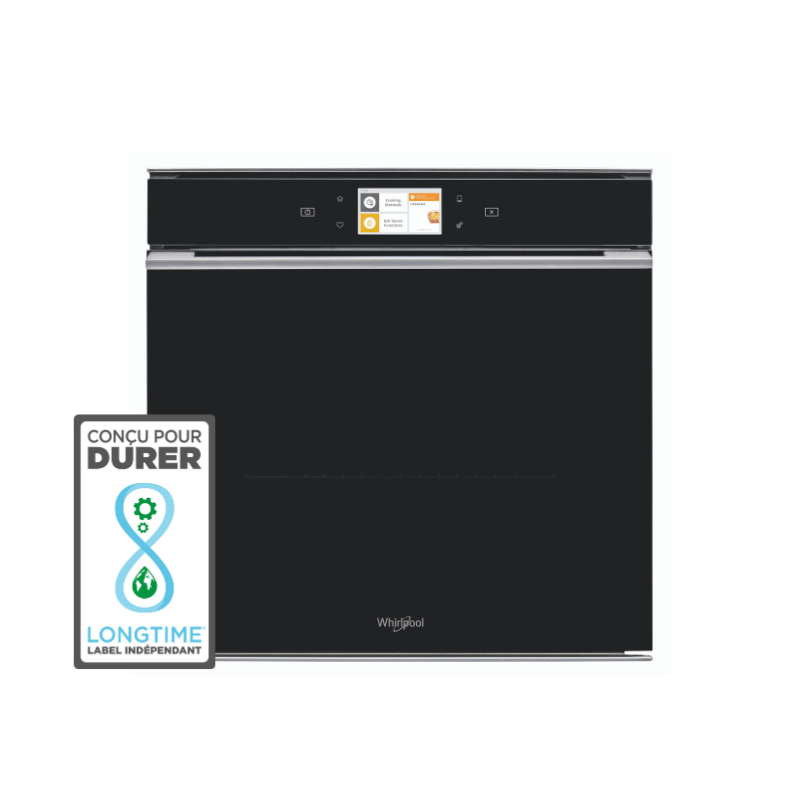How do I choose a durable electric oven ?
Want to know more about the durability of ovens? Read our buying guide to find out all about the robustness and repairability of electric ovens.
You want to find the best electric oven for your budget and your needs, so you can make a safe purchase. But to know which electric oven to choose, you need to understand the differences between the wide range of products available, from table-top electric ovens to built-in electric ovens and even electric pizza ovens.
By reading this guide, electric ovens will hold no more secrets for you, and you'll be able to enjoy the smell of apple pie and roast chicken browning gently in your oven on Sunday lunchtimes...

If the rest of this article seems a little complex, simply put your trust in the LONGTIME® label. Electric built-in ovens have recently been awarded the label after being independently and impartially assessed against our 41 sustainability criteria. And what's more, they're made in Europe.
How does an electric oven work?
What is an electric oven? Electric ovens work on a fairly simple principle. Resistors are placed in an insulating cavity called a "muffle". When an electric current passes through them, these resistors give off heat (thanks to the Joule effect!) and raise the temperature in your oven. The different oven families are classified according to the location of the resistors, the composition of the walls of the muffle (cavity) and the number and location of the fans in the oven.
The layout of the heating elements inside the oven, and the addition of new functions, enable different types of heat to be generated: natural convection, rotating heat, pulsed heat.
Muffles can have two types of walls: porous enamel walls (catalysis walls) or smooth enamel walls (pyrolysis walls).
Which electric oven should you choose: pyrolysis, catalytic, convection, steam?
Invented at the end of the 18th century, the use of built-in electric ovens has since been widely democratised and offers several functions and options. Let's take a look at the advantages and disadvantages of these different electric ovens so that you can make an informed choice.
Electric oven with natural or forced convection :
The natural convection cooking method is tending to disappear, to be replaced by revolving heat or even pulsed heat.
- Natural convection: Here the principle is very simple, a vault heater combined with a base heater produce heat and generate a circulation of hot air in your oven. This cooking method is much less efficient.
- Rotating heat: The principle of rotating heat is to circulate hot air.grâce à l’ajout d’un ventilateur (essential) in the bottom of the muffle. The result is more even heat and more efficient multi-level cooking.
- Pulsed heat: A step up again, pulsed heat uses the same principle as rotating heat, with the addition of a circular resistance at the bottom of the oven. The hot air is no longer simply stirred, but blown (pulsed) directly onto the food;
Choose a catalytic or pyrolytic electric oven:
With regular use, you'll soon find yourself asking the question : How do I clean a dirty electric oven?
Thanks to technical developments, it is now possible to clean your oven without using chemicals.
Catalysis and pyrolysis are the two self-cleaning systems used on the inside of electric ovens. The advent of these self-cleaning systems is a major advance in terms of the ease of use and maintenance of electric ovens, as they avoid the chore of manual cleaning while extending their lifespan. The only downside, particularly for pyrolysis ovens, is that this system requires extra energy to operate.
- Le four à catalyse : Catalysis ovens use the enamel properties of the muffle walls. The porous walls absorb food fats and destroy them when the oven temperature exceeds 200°C..
This method of cleaning has the advantage of using less energy, but is not as effective as pyrolysis. Check that the catalytic walls are available and accessible, as they have a short lifespan. Once they have become saturated with grease, you will need to replace them. - Le four à pyrolyse : Pyrolysis ovens use walls with a non-porous enamel structure. The heat of the oven is also used for self-cleaning, but the big difference with pyrolysis is that the temperature rises much higher, to between 400° and 500°. The result is that 100% of the dirt accumulated on the surfaces of the walls and glass is transformed into ash.
Why does my electric oven smoke? Why does my electric oven smell?
These are questions repairers are used to hearing. The main cause is a dirty oven. It's often food residues and grease stuck to the walls that produce these fumes and unpleasant odors.
This means you need to increase the frequency of cleaning.
Diagram of an electric furnace :
Built-in electric ovens, whether pyrolysis or catalytic, natural convection or fan-assisted, all follow a similar design scheme.
Anatomy of electric furnaces :
- Le châssis The chassis is the external part of your oven, forming the backbone of the oven. Combined with thermal insulation, it also protects the oven's external environment from the high temperatures (400°- 500°) reached in the cavity... quite essential!!!
- The muffle : This is the internal cavity of your oven. Its function is essential: to prevent the heat generated by the heating elements escaping outside your oven.
- La porte : The glass door on your oven means you can follow the cooking process without having to open the door. The less you open the oven, the less heat escapes, and the less energy you use!
- Electric resistors: Their essential mission is to produce the heat needed to raise the temperature in your oven.
- L’électronique : To cook properly, you obviously need to be able to adapt the cooking process. Electric ovens are therefore almost always fitted with electronic cards controlling the power supply, the display and the programming of the cooking temperature, cooking time and cooking mode.
- Control: To ensure optimum performance and controlled cooking, the ovens are fitted with a thermostat and a probe. The thermostat allows you to set the desired temperature (220° for example). The probe is responsible for reading the temperature in the oven. Once the temperature has been reached, the thermostat instructs the oven to reduce the electrical power passing through the heating elements, simply to maintain a constant temperature.
- The fan: Found only on convection ovens, fans circulate the air inside the cavity (muffle).
For each of the above elements, a wide range of industrial choices is available. The technical choices made by the manufacturer influence the performance, lifespan and price of your electric oven. But beware: your attitude to proper maintenance will also influence the lifespan of your oven.
The resistor, the heart of the electric oven:
Electric resistors are essential for the operation of your electric oven. The quality of these resistors is vital to ensure that your product works for a long time.
- La résistance de voute : This is the heating element at the top of your electric oven, which is clearly visible and allows you to brown and bake au gratin. Take care not to damage it when you put dishes (casseroles for example) in the oven.
- La résistance de socle : This is the heating element at the bottom of your electric oven. On built-in electric ovens, this is usually invisible;
- La résistance circulaire : This is a heating element found on electric ovens equipped with pulsed heat. This element is located on the bottom of your electric oven.
A little tip: Remember not to leave the fry-dryer at the bottom of your oven when you are using a cooking mode that uses the base element. This will raise the temperature of the heating element and you risk damaging it.
Electronic boards for electric ovens :
The electronic board is the brain of your oven. The electronics control the cooking temperature by varying the power of the electric current circulating through the heating elements and the duration of the cooking time;
Depending on the heating mode selected, the oven will start either the base, vault or circular heater, and the same applies to the fans.
The electronic board is also fitted with safety components to cut power to your oven in the event of overheating or malfunction.
Your oven may include one or more electronic boards, such as the main board, the control board or the display board.
The electronic board and other components are sensitive elements. They have a major influence on the durability of your oven. Low-cost components, an undersized power supply or capacitors and your product will only last a few years.
The electric oven cavity :
Otherwise known as the muffle. To raise the temperature, your oven must be able to concentrate and retain the heat produced by the heating elements in its cavity. The quality of the cavity is therefore essential, and this is based on two points: the quality of the enamelling and the thickness of the wall.
You're going to tell me that it's difficult to assess the enamelling on the walls of an electric oven with the naked eye! Yes, that's true. But there are certain indicators that should alert you, and price is often one of them. So watch out for ovens that are priced well below the rest of the market.
The better the cavity insulation, the less energy your electric oven will need to heat up.
A little tip: Choose an oven with rack supports that do not touch the walls. These rack supports have the advantage of preserving the integrity of the enamel on the walls of your electric oven by preventing the racks from rubbing when they are moved. This is a real advantage when it comes to extending the life of your electric oven.
Electric oven door :
Opening, closing, opening, closing, the door of your electric oven is going to be under a lot of stress. Both mechanically (hinges and closing) and thermally (pyrolysis). The quality of this door is essential, and like the cavity, the door has an insulating function. The better the insulation, the less energy your oven will lose.
The door is generally made up of a frame, an inner and outer frame, inner and outer glass panes, a handle, hinges and a locking system for pyrolysis ovens.
Over time, the quality of each element will make all the difference. But beware of misuse:
- Don't slam the door: You'll damage your seals and risk damaging the glass if a dish or grille sticks out a little.
- Do not place anything flat on the door: The door is absolutely not designed to bear weight. Doing so could cause serious damage to the hinges or even break them.
- Do not wet the glass immediately after pyrolysis: During pyrolysis, the temperature of the oven's inner glass will rise very high. If you clean it with a cold sponge, there is a risk of thermal shock and the glass could explode;
A little tip: the glass in the door, combined with the light in your oven, allows you to follow the cooking progress of your food. The less you open your door, the less heat you'll lose and the less energy and money you'll spend! Make sure your light is working properly and that your door stays clean.
How to install a built-in electric oven :
Warning: any work on your switchboard, your network or your sockets is highly risky. The above paragraph is for information purposes only. Only a professional, such as an approved electrician, can carry out work of this nature, in compliance with standard NF C 15-100, to avoid any risk of accident, fire or electrocution.
If you want to use your electric oven in complete safety, it's important not to ignore the safety instructions. Make sure you read the instructions carefully to check the installation conditions.
To protect your safety and avoid any risk of damage to your equipment or your environment, your oven's electrical circuit must be adapted to its power rating. As a minimum, the NF C 15-100 standard requires a dedicated circuit for your oven, depending on its power rating. This means that the electrical line connecting your socket to your switchboard must be used only for this purpose, and that the diameter of the conductors must have a minimum cross-section of 2.5mm2. This electrical line must be protected at the switchboard by a circuit breaker rated at least 20Amp. The higher the power of your oven, the higher the cross-section of the wires and the protection of the switchboard.
How to connect an electric oven without a plug?
There are several possible scenarios, depending on your oven's power rating, as well as depending on the configuration of your system. In all cases, you'll need to match your product to your installation.
- Your electric oven has an electric cord with a plug, but the dedicated line on your wall is a cable outlet without a plug. You have two options: replace your oven cord with a plugless oven cord or replace your wall cable outlet with an electrical socket.
- Your electric oven is fitted with a power cord that has no plug, but the dedicated line on your wall has a wall socket. Replace your power cord with a cord fitted with a plug or replace your wall socket with a cable outlet.
- Your electric oven and your wall are fitted with sockets that are not compatible. This situation is a little more complex and we recommend that you seek professional advice;
A word of advice: Please note that we strongly advise against modifying or altering the electrical cord on your oven without the intervention of a competent person and without the approval of your distributor or the manufacturer. Doing so could put you at risk and/or cause you to lose the warranty covering your product.
How to build in an electric oven?
Whether your electric oven is free-standing or built-in, it's important to check that the oven's direct environment is safe, and that the dimensions of your chosen electric oven are compatible with the dedicated space in your kitchen.
As well as being ergonomic, a high-mounted electric oven frees up space on worktops. The vast majority of built-in ovens are standardized in size, allowing them to be fitted into specially designed niches. The operation presents no major difficulties, but two people are needed to lift and insert the oven into the niche.
Once the oven is in place, refer to the user manual to check how to secure it. Generally speaking, the door must be opened to install two screws on the side jambs.
How to make your electric oven last as long as possible:
As with any product, to get the most out of your electric oven, certain recommendations for use and maintenance are essential:
- Read the instructions! Yes, nobody does, and that's a shame. With this type of appliance, it's important to be aware of the recommendations for use and, above all, maintenance. And if something isn't clear enough, ask the dealer or manufacturer.
- Follow maintenance recommendations. This is essential for optimal, trouble-free cooking. Remember not to leave any food in your oven - it's not an eaten keeper!
- Use the drip tray wisely, and if you're not using it, remove it from the oven to avoid damaging your floor heating element.
- Use correctly sized dishes to avoid overflow and melted cheese in the oven!
- Do not place a dish on the oven door and do not slam the door.
- Clean your oven regularly using pyrolysis for ovens equipped with pyrolysis or a damp sponge for catalytic ovens, but without damaging the enamel.
- Choose an oven that can be repaired. Even with reliable products, breakdowns and accidents do happen, so find out about the availability of spare parts for your product. Ovens with the LONGTIME label must have parts available for 10 years.
Which wattage to choose for an electric oven :
It's not easy to give a clear answer to this question. An oven's electrical power is not the only indicator of its efficiency. The oven's design and quality come directly into play:
- A 3000W electric A oven with a bad muffle and a poorly insulated door will take 1 hour to bake and consume 1 kw.
- The 2500 watt electric B oven with a quality muffle (thick wall) and a well-insulated door will require 45 min of cooking time and consume 0.5 kw.
The B oven design conserves heat, requiring less cooking time and less energy to maintain the oven temperature.
To make the right choice, we advise you to check that the wattage is adapted to the dish you'll be cooking, and also to choose an oven with a good ratio of electrical power to low power consumption.
Repairing your electric built-in oven :
Electric ovens are less complex than other products, and should be easy to repair in the event of failure.
An essential point when it comes to durability, make sure that the manufacturer of your oven has a high-quality after-sales service and that spare parts for your product are accessible. All products with the LONGTIME® label are repairable, so don't throw them away if they break down.
Your electric oven trips:
- The first thing to do is make sure that the problem is not with your electrical network or simply your plug. Test your plug with another device or have your cable outlet tested with a multimeter.
- Make sure that the wires from the oven terminal block and the cable outlet are correctly tightened.
- Another possibility is that an oven that trips often has a damaged heating element. If the resistor is damaged, there's a current leak. Your switchboard detects this thanks to the differential circuit breaker and cuts off the current.
- The electronics may be to blame: capacitor, thermal fuse...
Your electric oven turns itself off:
- First of all, make sure you haven't chosen a setting or program that turns off your oven.
- The programming module may be faulty and responsible for this outage.
It even happens (rarely) that ovens start by themselves, but don't panic, it's not a ghost. To check whether the programmer is to blame, try selecting a cooking mode where the programmer is not involved. - If your electric furnace shuts down, a safety device may have been activated. We need to find out why. A faulty sensor or thermostat, a fan that no longer works, an electronic problem...
Your electric oven no longer heats up:
- Once again, make sure you have chosen the right setting or programme. Some ovens are equipped with a low temperature programme, for raising pasta for example;
- If your settings are correct, it's possible that one or more resistors are to blame. You'll then need to test them.
- The thermal management system (sensor/thermostat) may also be at fault, delivering erroneous information.
Your oven door is jammed:
- Some ovens have electric or electronic door locks. This is particularly the case with pyrolysis ovens. When pyrolysis is activated, the door is locked to prevent any risk of burns. The door is released once the oven has cooled sufficiently.
- If your door is really blocked, you should remove the oven from its housing to check the cause of the blockage. However, in the case of built-in ovens, it is very difficult to remove the oven from its housing without opening the door. So check with the manufacturer or your repairer what procedure to follow to avoid damaging your furniture and your oven.
Your oven controls are no longer responding:
- The electric ovens are equipped with a control panel, allowing us to control the cooking modes, cooking temperatures and cooking times. If these controls no longer respond, you may have a problem with a module or with the electronic control board.
- It's rare for this to happen, but your display screen may also be experiencing problems. There are two possibilities: either the problem comes from the display module (lcd screen for example) or it's the electronic display card that's faulty.
The cooking performance of your electric oven has decreased:
- When your oven is a fan assisted or convection oven, fans are installed in the oven cavity. If the fans fail, cooking performance will be reduced.
Once you've ruled out these first options, and in the event of a proven breakdown, check whether your electric oven is still covered by the legal guarantee of conformity (24 months in France). If this is the case, contact your dealer, who will be happy to suggest a solution.
If your device is no longer under warranty, you have several options:
- In all cases, first contact the after-sales service of the brand of your product, providing the model identification. All products bearing the LONGTIME® label must include product identification details. (e.g. serial number, model, technical reference, etc.). The after-sales service may be able to carry out some checks with you and suggest an approved network if one is available.
- You can also contact a professional repairer listed in the Répar'acteurs directory, for example. As a reminder, apart from the legal guarantee of conformity, you are free to choose your repairer.
- Finally, you can opt for DIY (self-repair), but as with all electrical and electronic products, make sure you have a solid grounding in the basics so you can intervene in complete safety.
To sum up, when choosing an electric oven :

To choose an electric oven :
- Define your needs and priorities when choosing a built-in or freestanding electric oven, pyrolytic or catalytic.
- Ask about the quality of the muffle, electronics, resistors and door.
- Make sure priority parts are accessible: electrical resistors, electronic board, control module.
- Find out about the quality of all the oven's electronics.
- Check that the muffle has grid doors to preserve the integrity of your walls.
- Choose brands with a véritable support technique and check the spare parts availability policy before you buy.
Would you like to buy an electric built-in oven without having to take an engineering degree in research and development or comb through 15 blogs and 4 consumer magazines?
Take a look at our product directory and you're sure to find what you're looking for.

